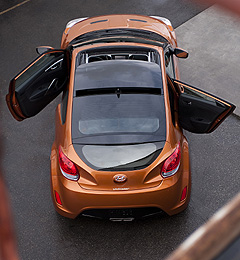Make / Model Search
News - HyundaiHyundai heralds hi-po foursCool coupe: Veloster will hit Australian roads by January, but could also be available with turbo power next year. Veloster’s turbo engine breaks cover, alongside Hyundai’s Euro 6 2.0 R-Series diesel26 Oct 2011 HYUNDAI has revealed the fruits of its whitecoat labours over what it says was the last 52 months – at a cost $59 million – in the form of a cracking new 1.6-litre turbo-petrol four-cylinder engine and a Euro 6-compliant 2.0-litre R-Series diesel. Most likely to debut in the Korean steamroller’s upcoming Veloster coupe – possibly as soon as next month’s Los Angeles motor show – the Gamma 1.6 T-GDI packs a twin-scroll turbocharger, air-to-air intercooler, direct-injection and dual continuous variable valve timing to crank out 152kW at 6000rpm and 265Nm of torque at 1750rpm. As such, the more powerful turbocharged version of the Hyundai group’s new 1.6-litre GDI (gasoline direct injection) engine, which has been available in Kia’s new Rio since September but will make its Hyundai debut in the all-new Veloster around the end of this year, is claimed to deliver the best performance in its class. At the same time, the 1.6 T-GDI – which follows the US-only Kia Optima Turbo’s 204kW/365Nm 2.0-litre petrol-four - meets California's stringent ULEV-2 (Ultra-Low Emission Vehicle) and Euro5 emissions standards. Hyundai will not say which models its first 1.6-litre turbo-petrol engine will power, but a Veloster Turbo is widely expected to go on sale in the US by mis-2012. As we’ve reported, the Veloster will be powered by Hyundai’s latest non-turbo 1.6 GDI engine when first shipments arrive here in December, delivering the same 103kW at 6300rpm and 167Nm at 4850rpm outputs as the Rio light-car. The high-revving powerplant will be matched to a choice of six-speed manual gearbox or the brand’s first six-speed dual-clutch transmission (DCT), which is similar in design to existing units such as Ford’s Powershift and Volkswagen’s DSG. A more powerful SR version of Hyundai’s own closely related Accent hatch, launched here in August - is expected to also be powered by the 1.6 GDI mill, which represents a sizeable advance over the older 91kW/156Nm MPI Gamma unit found in regular RB Accents. The non-turbo 1.6 GDI returns fuel consumption of 5.9 litres per 100km in the regular Veloster, and as little as 5.6L/100km in the Rio, while the turbo version adds a bedplate sump design and serpentine auxiliary belt to enhance engine reliability. Hyundai has also revealed an upgraded Euro 6 emissions-meeting version of the 2.0-litre R-Series turbo-diesel engine that currently powers the ix35 compact SUV.  Revealed alongside the 1.6 T-GDI at the 11th Hyundai-Kia International Powertrain Conference on October 19, the cleaner diesel gains low-pressure exhaust gas recirculation and other technologies to reduce nitrogen oxide (NOx) emissions by 56 per cent compared to Euro 5, as well as meet European CO2 standards not due in effect for two years. Revealed alongside the 1.6 T-GDI at the 11th Hyundai-Kia International Powertrain Conference on October 19, the cleaner diesel gains low-pressure exhaust gas recirculation and other technologies to reduce nitrogen oxide (NOx) emissions by 56 per cent compared to Euro 5, as well as meet European CO2 standards not due in effect for two years.However, outputs of the latest R-2.0 engine are down from 135kW and 392Nm to 110kW and 382.5Nm. Hyundai also used the powertrain conference, which was attended by about 1000 powertrain experts and academics at Rolling Hills Hotel near the Korean giant’s Namyang R&D centre last week, to display its motor-integrated six-speed front-wheel drive automatic transmission, six-speed DCT, Theta T-GDI petrol engine, Kappa bi-fuel petrol and R-2.2 diesel engine with two-stage turbocharger. The latter continue to produce 145kW and 436Nm in the Santa Fe mid-size SUV, which should be replaced by an all-new model dubbed the ix45 – powered perhaps by an upgraded Euro 6 R-2.2 diesel – next year. “Due to stricter environmental regulations and policies that vary from nation to nation, competition in the development of powertrains and other core technologies is intensifying,” said Hyundai Motor Company vice-chairman Woong-Chul Yang. “Hyundai Motor will accelerate its efforts to develop future powertrains that feature high-performance and eco-friendly engines and transmissions.” Going one step further, late last month the Hyundai group committed to producing all-new compact electric cars for both of its brands by 2015. Kia announced it would produce its first global all-electric vehicle in the first half of 2014. Kia Motors Australia is currently developing a business case for its first EV, which will most likely be based on the next-generation Soul due to appear in 2013. Hyundai’s second EV, following the Korea-only i10-based BlueOn, will follow in the second half of 2015, while Hyundai is also developing a plug-in hybrid vehicle and hydrogen fuel cell-powered version of the ix35. Before then, however, Kia will release its first EV in Korea by the end of this year in the form of a small, box-shaped zero-emissions vehicle based on the Picanto sub-light hatch, Codenamed TAM, Kia plans to build 2000 examples of the sliding-door electric van this year, initially only for the domestic market.  Read more |
Click to shareHyundai articlesResearch Hyundai Motor industry news |












Facebook Twitter Instagram